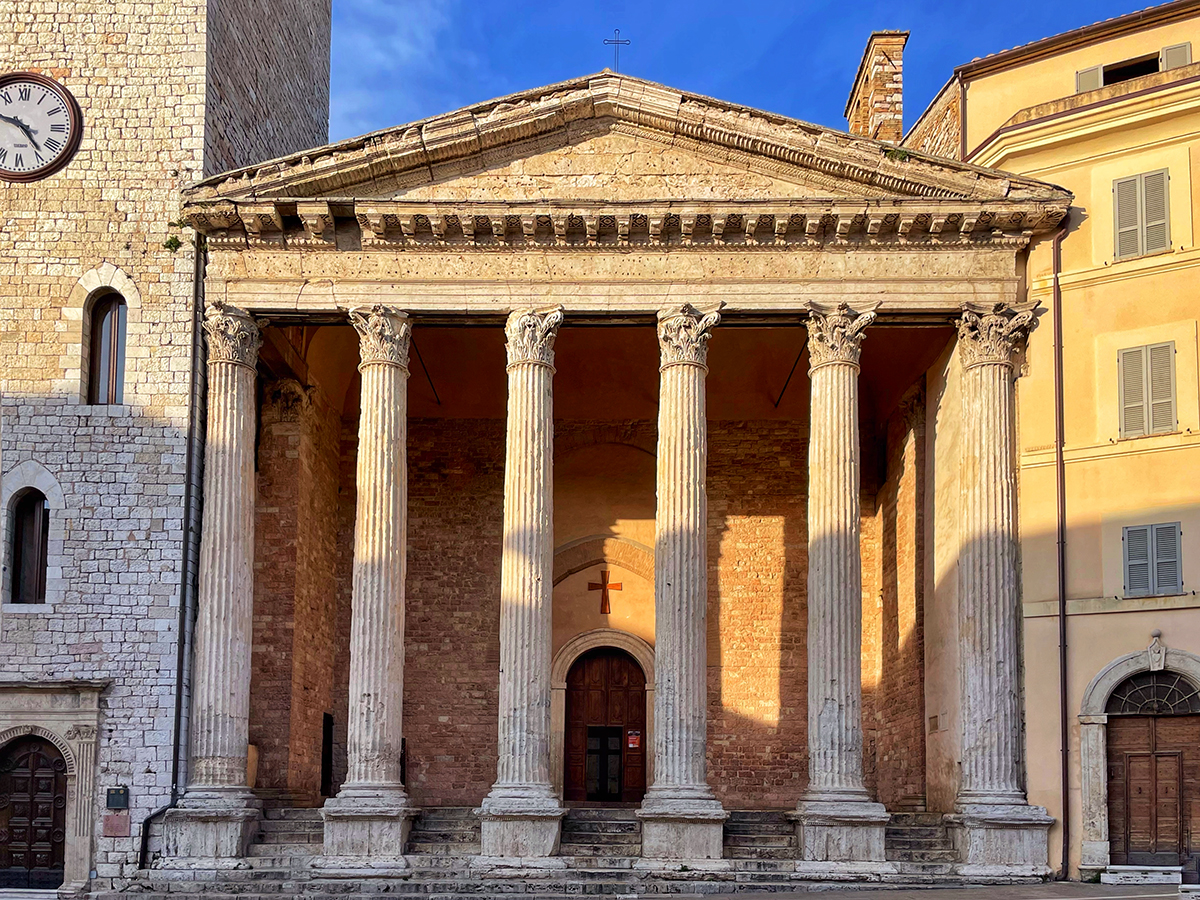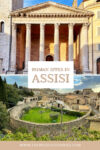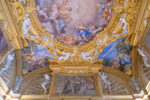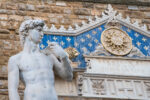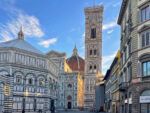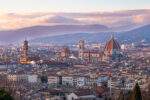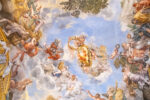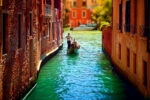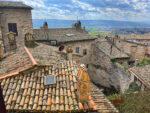Nestled in the heart of the Umbrian hills lies the picturesque town of Assisi. While it may be most well-known as the birthplace of Saint Francis, the town’s ancient Roman heritage is equally fascinating. From ancient temples to ancient city walls, Assisi, or Assisium, is a charming gem that will leave you enchanted.
Like most Roman cities, Roman Assisi was surrounded by a defensive stone wall, had an aqueduct bringing water from the mountains, several cisterns to hold this water and fountains to deliver water to the inhabitants. The city was important enough to have an Amphitheater, a Circus, a Theater, Forums, Temples, Public Baths, Villas, and Mausoleums.
In 238 AD, Assisium was converted to Christianity by a missionary from Anatolia, Rufinus. After preaching Christianity in Assisium, Rufinus or Rufino was martyred by a Roman Consul, Aspasius, in the 3rd century AD and consequently became Assisi’s patron saint.
Some five centuries after it was founded, Assisium was largely destroyed by the Ostrogoths in 545, and the town entered the Middle Ages as part of the Lombard-ruled Duchy of Spoleto.
Not much is known about Roman Assisi. Most of it lies buried underneath Assisi’s charming medieval streets. This, of course, makes Assisi one of the best towns in Umbria for exploring layers upon layers of history. And there are a lot of things to do in Assisi to keep you busy exploring.
Temple of Minerva
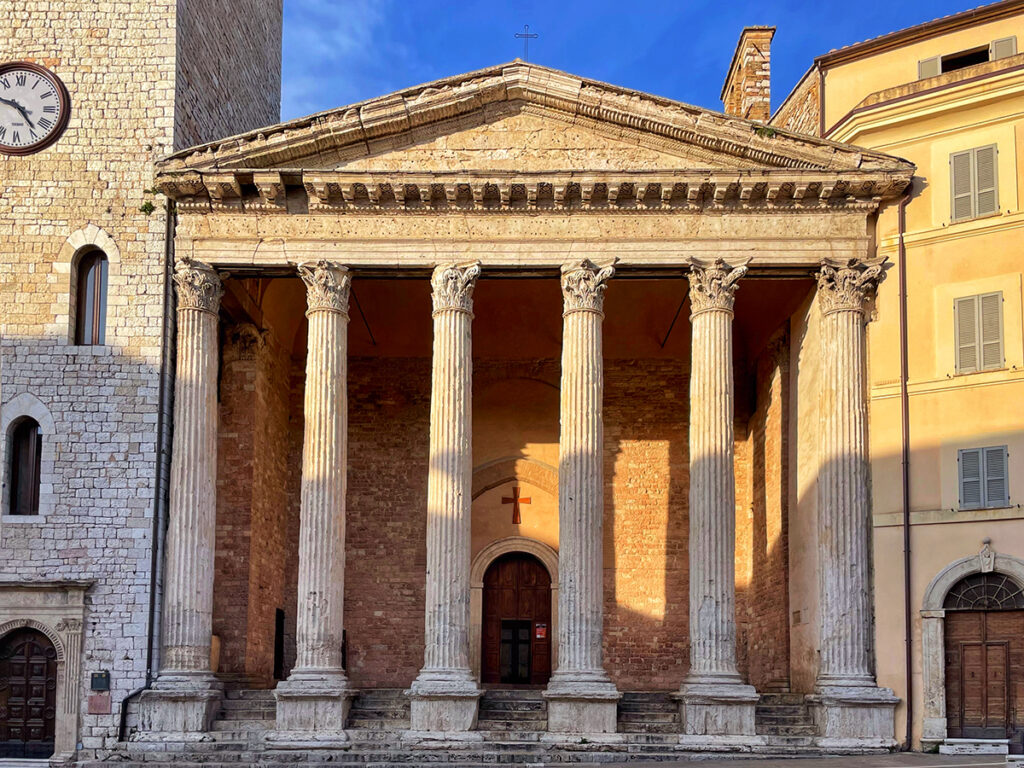
The most spectacular remaining visage of Roman Assisi is the Temple of Minerva which still dominates Piazza del Comune. Built in the 1st century BC, it was dedicated to the Roman goddess of wisdom, justice, law, victory, and the sponsor of arts, trade, and strategy. Minerva’s symbol is an owl, and it is quite fitting that the Renaissance archway across the square from the temple features an owl among its grotesque-style decorations.
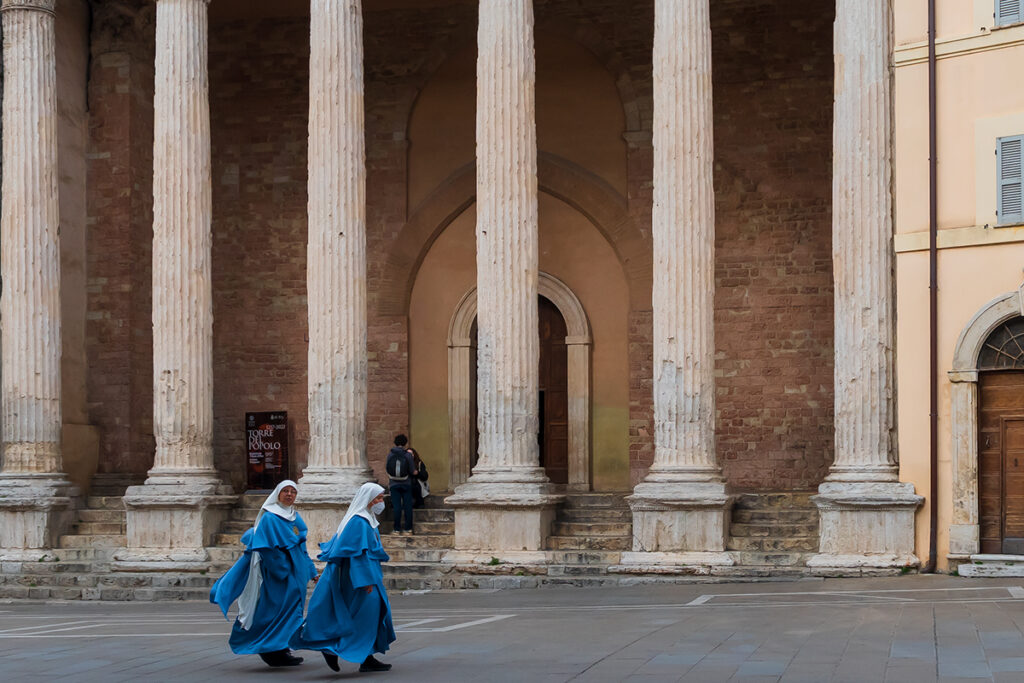
The temple was converted to a church of Santa Maria sopra Minerva in 1539, which is probably the reason it survived in such an extraordinary state of preservation to our days. In fact, the temple’s facade of six Corinthian columns supporting the architrave (the beam above the columns) and a small pediment (the triangular section above) is considered one of the best-preserved facades of this kind in Italy.
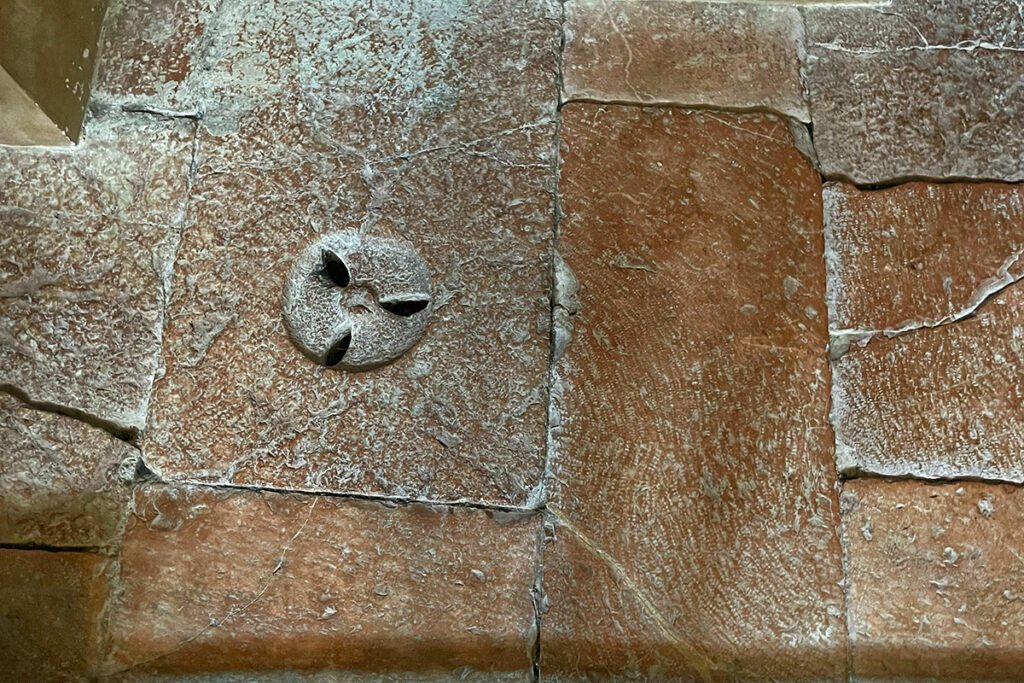
Inside the church, you can see the original Roman floor on both sides of the altar, complete with ornate drains for the blood from the sacrifices to flow.
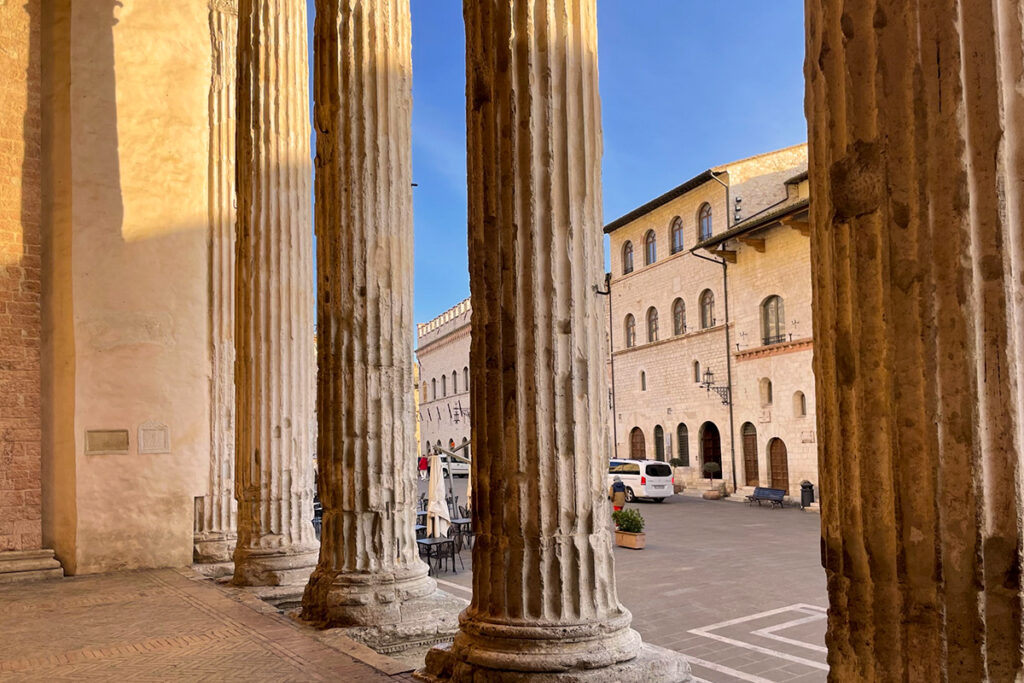
In front of the temple facade, there are white lines painted on the pavement to mark the edge of the Forum, the central square of Roman Assisi the remnants of which are preserved underneath Piazza del Comune in The Roman Forum and Archaeological Museum.
The Roman Forum and Archaeological Museum
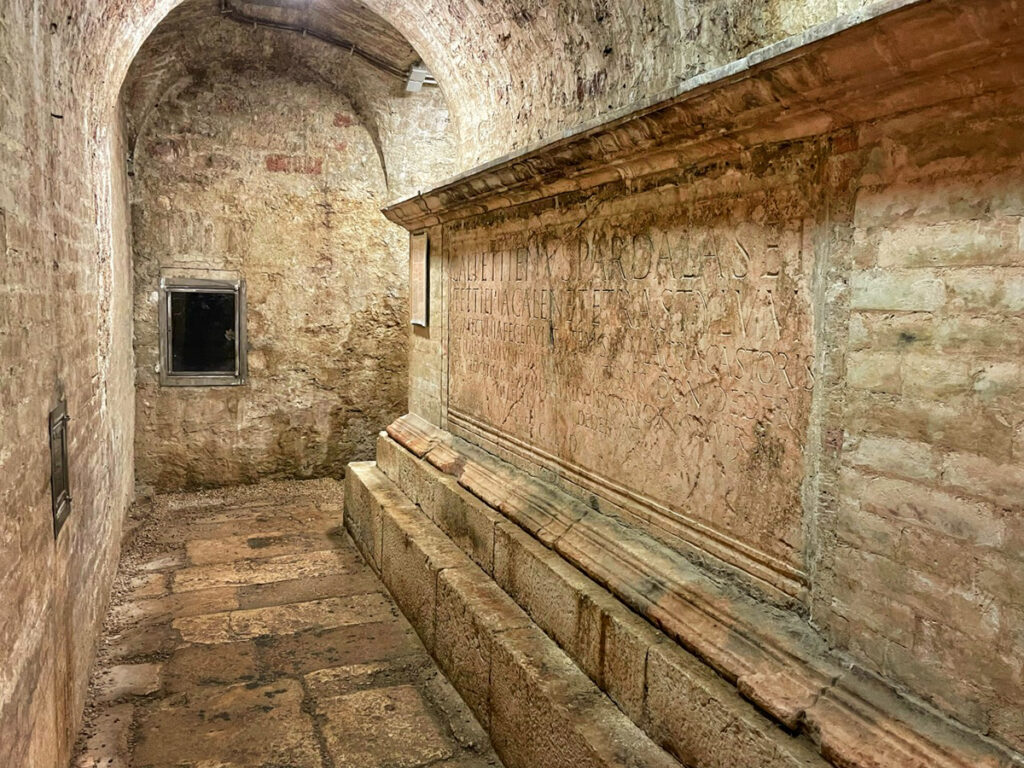
Accessed from Via Portica, the museum preserves not only what’s left of the Roman Forum, which was found during excavations in 1836, but all kinds of Roman artifacts discovered in various archaeological digs in Assisi.
Tip: If you also plan to climb the Popolo tower during your visit, instead of buying the entry ticket for the archaeological museum, get a combined ticket from the Tourist office on Plaza del Comune and save a few euros.
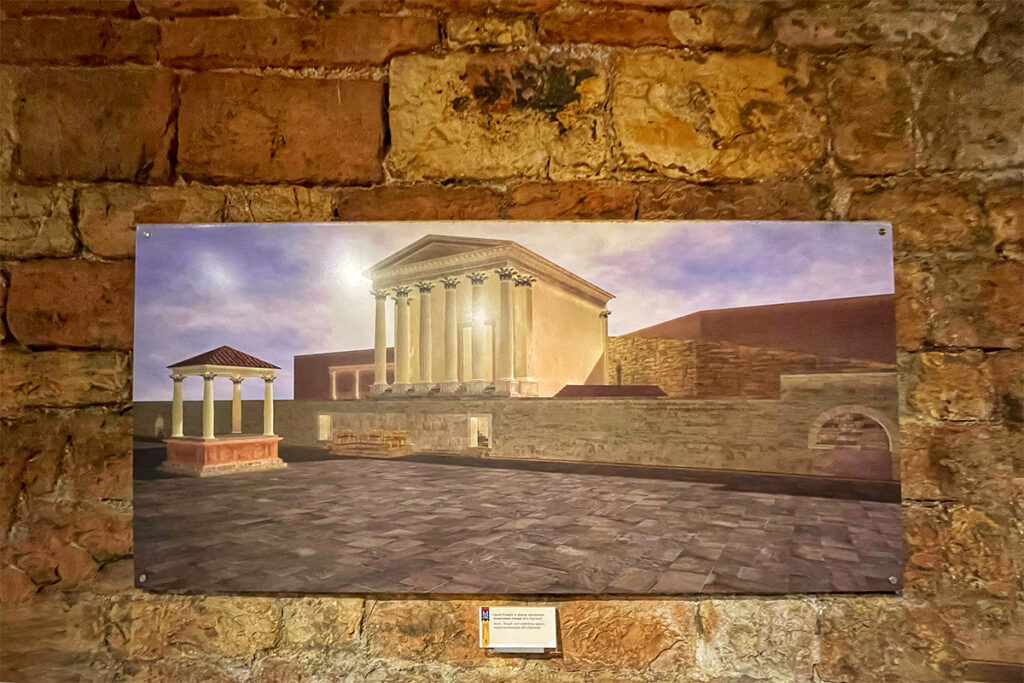
The archaeological museum is well presented as a path through a tunnel towards the wider area underneath the plaza. Here you’ll find the base of the temple with the discernible access doors, a monumental cistern, the remnants of a podium with the seats for the judiciary, and the base of a smaller temple dedicated to Castor and Pollux. Another room contains three marble statues found in the Forum.
The video playing in the museum shows the reconstruction of the forum, including the Temple of Minerva, the temple of Castor and Pollux, and the market stalls around the perimeter. There is also a model of the forum on display. It’s a fascinating museum for Roman culture buffs.
You can also see some frescos from domuses or villas excavated in Assisi in recent decades, one under Palazzo Giampè and one under the church of Santa Maria Maggiore. The domuses can only be visited with a tour, so if you haven’t organized one (more on this in the relevant sessions below), here’s your chance to see some Roman art from these villas.
The Amphitheater
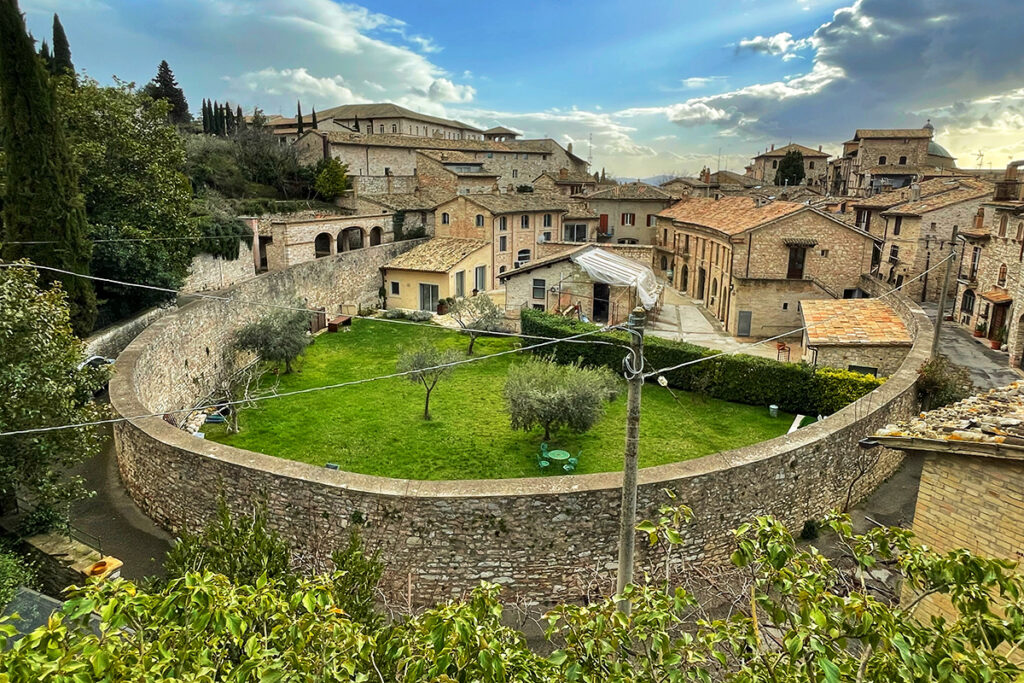
Roman Assisi must’ve been an important city to have its own amphitheatre, which is essentially two semicircular theatres put together to form a full circle.
Built in the first half of the 1st century AD, the Amphitheater was located between today’s Piazza Matteotti and the medieval gate, Porta Perlici, at the eastern end of town. Not much remains of the structure, but you can clearly see its elliptical shape between the garden wall and the line of medieval houses that were built on the amphitheatre’s foundations.
The course of Via Anfiteatro Romano traces the former boundary of the structure. Climb the stairs to the street above and you’ll have a bird’s eye view of the amphitheatre.
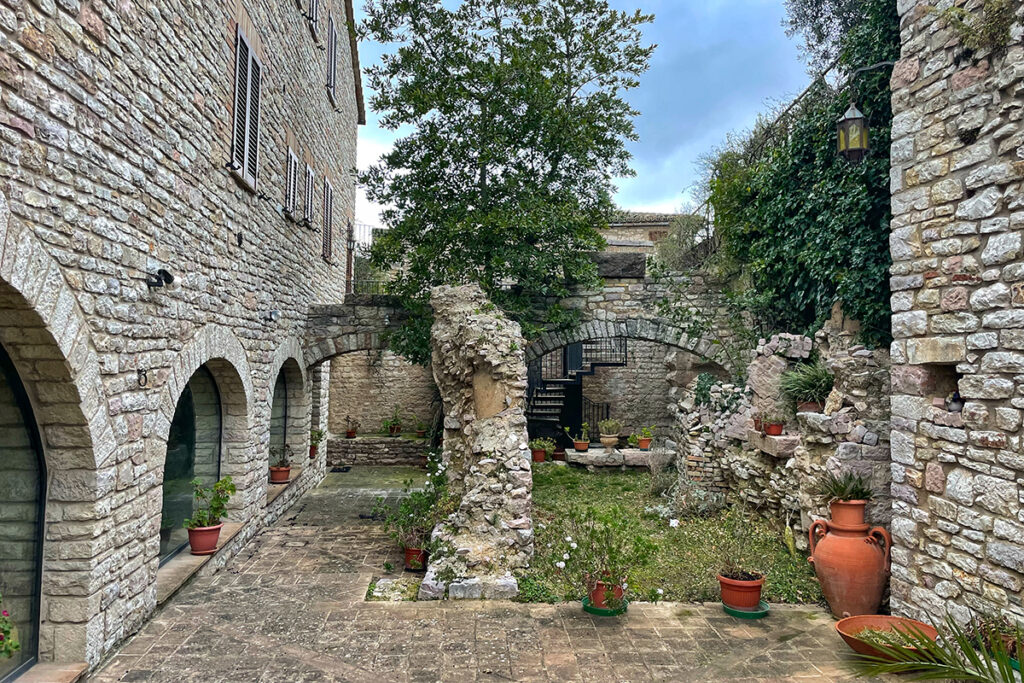
In a private house, on the left-hand side when you are facing the modern-day entrance to the amphitheatre, there are some impressive pillars that mark the former monumental entrance. You can see one of the pillars, encrusted in medieval bricks and stones through the bars of the property’s gate.
Gladiator Tunnel
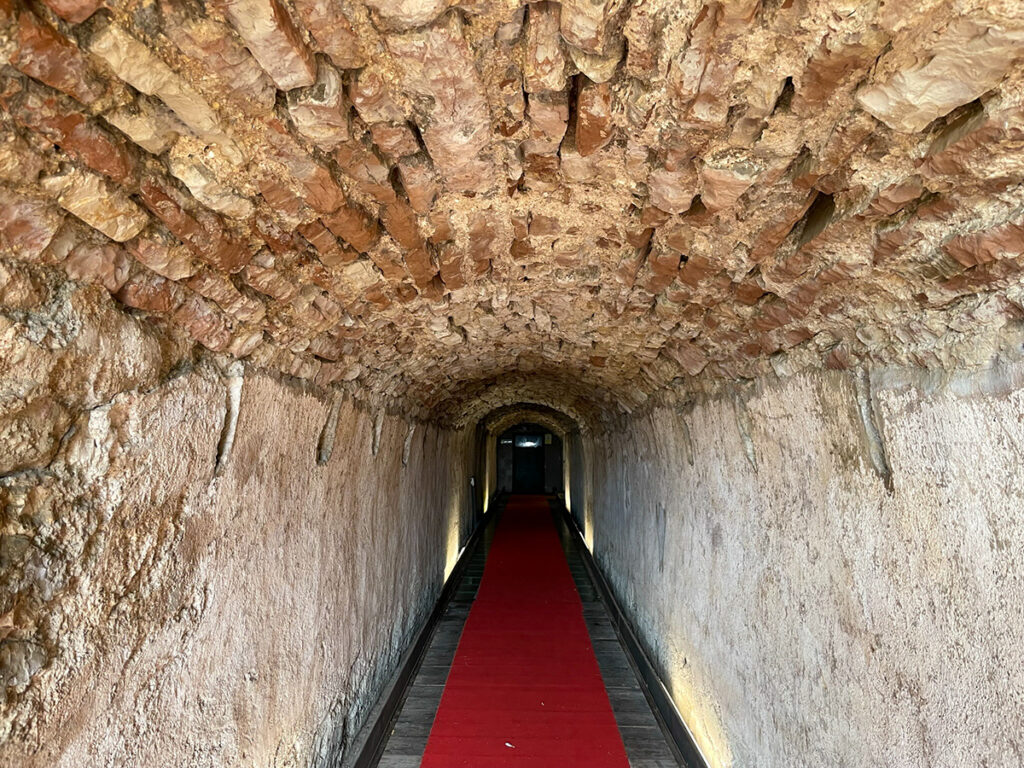
The Gladiator Tunnel is one of Assisi’s hidden gems. It runs from the car park on Viale Galeazzo Alessi, near San Rufino Cathedral all the way to the Amphitheater, although only 180 meters of it are open to the public. Made of small pink limestone blocks, the tunnel is 2.4 meters tall and 1.8 meters wide.
The tunnel served as a passage for gladiators and caged beasts to the Amphitheater arena. It is thought that Gladiator barracks must’ve been nearby.
To find the tunnel, navigate to Tunnel Romano on Google Maps. The entrance to the building of the car park is from Viale Galeazzo Alessi. There is a sign for Tunnel Romano on the building. When you walk into a boring-looking foyer, take the elevator to the top or walk up the stairs. You come out at Terrazza Don Aldo Brunacci with beautiful views of Assisi and Santa Chiara Basilica. Follow the terrace and it will take you to the tunnel.
Cistern of San Rufino
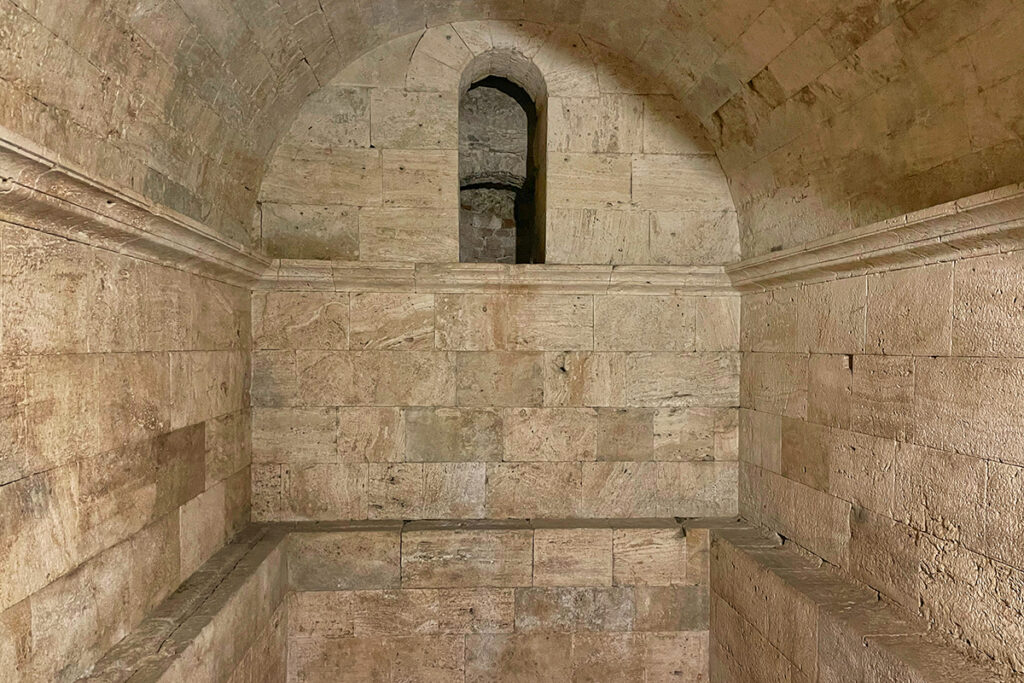
One of the most important requirements for flourishing cities is access to fresh water and Romans had the water delivery system down pat. Stone aqueducts delivered water from the surrounding countryside and massive watertight cisterns were used to store water (much like the magnificent Basilica Cistern in Constantinople (modern-day Istanbul).
One of Roman Assisi’s cisterns can be seen in San Rufino Cathedral. The cathedral was built on top of an earlier church that in turn was built on top of a Roman cistern.
The cistern is the first ‘room’ on your left when you enter the cathedral. It is a large solid construction with an arched ceiling and a hollowed-out water drain that has been incorporated into the structure of the church. The floor of the cistern is made from lime mortar and crushed bricks which makes it watertight.
Water from the Aqueduct
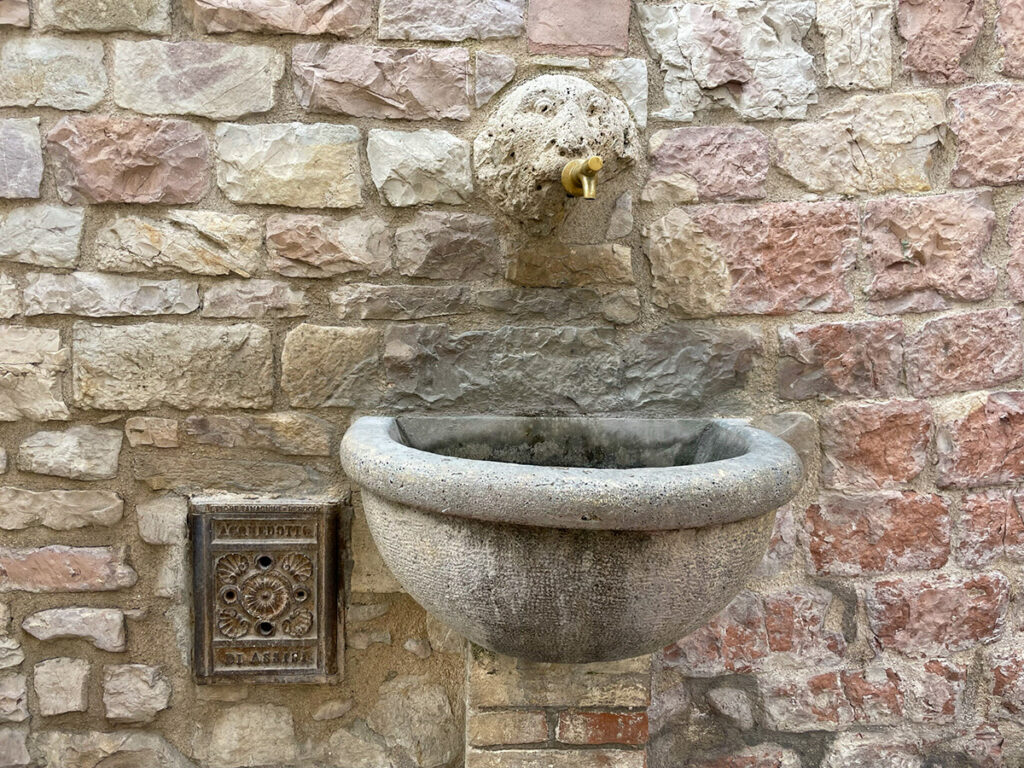
As you wander around Assisi, you’ll often see small brass taps built into its medieval walls. These taps are connected to the aqueduct that brought water to Assisi cisterns and that still brings water to the town from the surrounding hills.
This is probably the freshest water in town. Some say that the locals frequently use these taps to get fresh mountain spring water. I haven’t seen anyone do that during my time in Assisi, but I did try the water and it tastes very fresh indeed.
The water from the aqueduct also served the public baths in Roman times. And while there are no Roman baths surviving in Assisi, there are several medieval laundry areas, one right next to the Amphitheatre that probably benefited from the Roman water sources. The most spectacular example of such recycling in Italy is the Trevi fountain in Rome – it is built on the site of the Roman baths, where the pipes connected to the aqueduct ended.
Terrace and Bona Mater Sanctuary
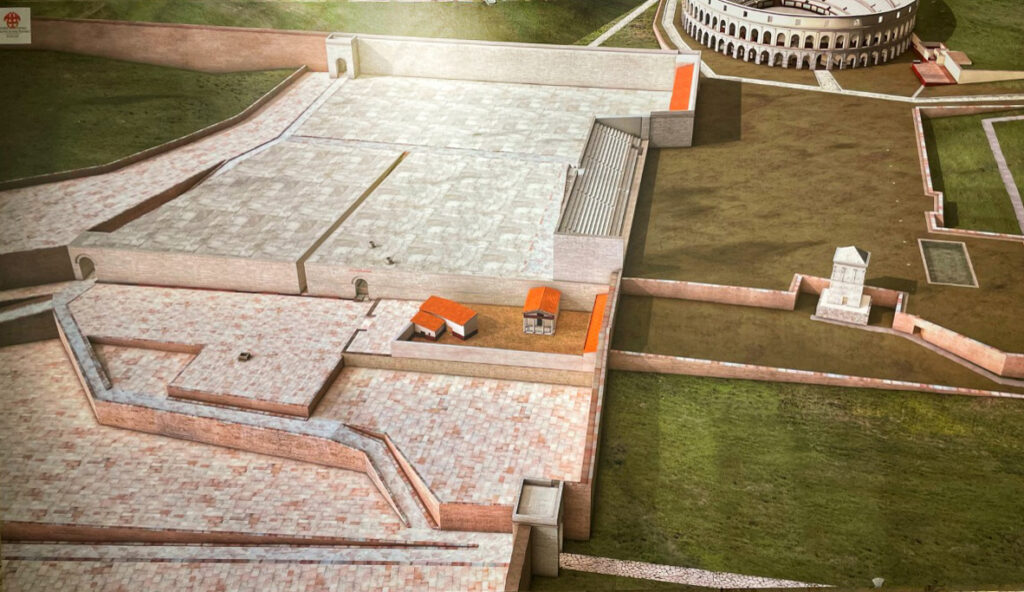
Rufino, who was an Anatolian Christian priest, arrived in Roman Assisi in the early 3rd Century AD to preach Christianity to the pagans, for which he was later executed by the Romans.
Legend has it that when his body was found in the river Chiasio and transported to Assisi, it was taken to the location near Bona Mater Sanctuary. At that time the area was in a state of complete neglect. Later, in the 8th century, the first basilica was built in honour of St Rufinus near the ruins of the Bona Mater (Holy Mother) sanctuary. It was easier to build on the ruins of an earlier structure than properly demolish the older site.
To get an idea of what Bona Mater sanctuary and the surrounding forum looked like in Roman times, you need to venture beneath San Rufino Cathedral to The Cathedral Underground Museum. The museum is a Roman site underneath a church underneath a cathedral. It is a subterranean treasure chest of Assisi’s history.
One of the most interesting underground treasures is a Roman sarcophagus from the 3rd century AD. According to legend, San Rufino was initially buried in this sarcophagus.
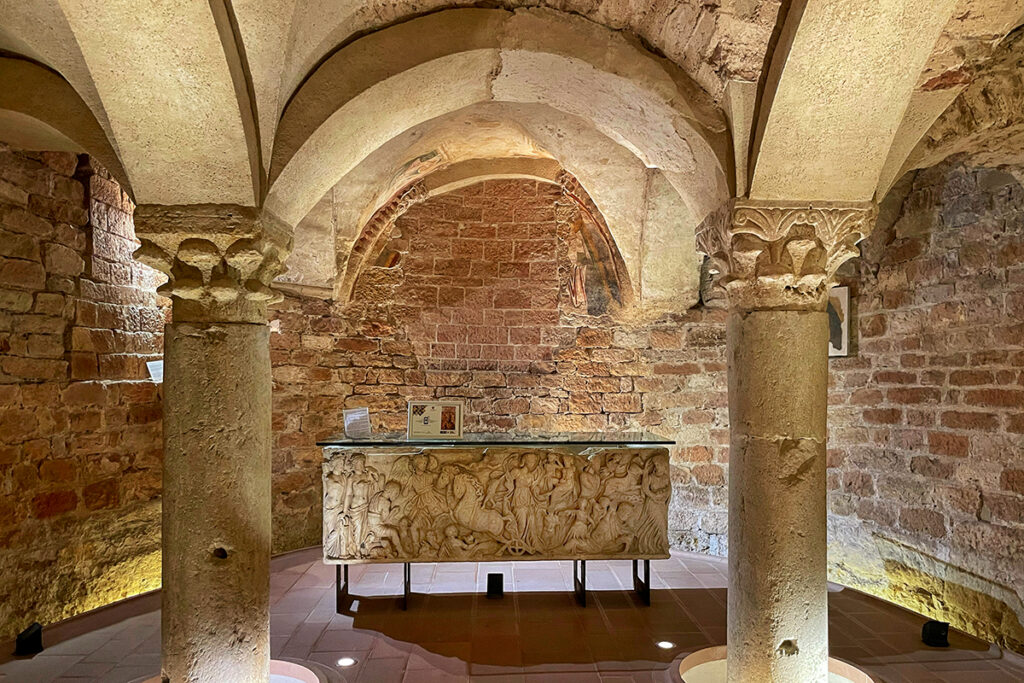
Another gem is a room that shows reconstructions of the Roman terrace that stood on this site before San Rufino’s time.
The terrace was divided into two zones on two different levels. The elevated eastern zone, housed the surrounding wall, the cistern (the upper part of which you saw inside the cathedral) and the fountain, and the sanctuary of Cupra Mater – the Etruscan goddess of love and fertility.
When in 90 BC, Asisium became a Roman municipality and the official language changed to Latin, the Etruscan goddess Cupra became Bona in Latin – the Roman equivalent of Venus.
The lower zone to the west of the cistern was taken up by the large square with a public fountain – the source of fresh water for the city’s inhabitants. The two zones were likely linked by a narrow staircase.
Roman Road
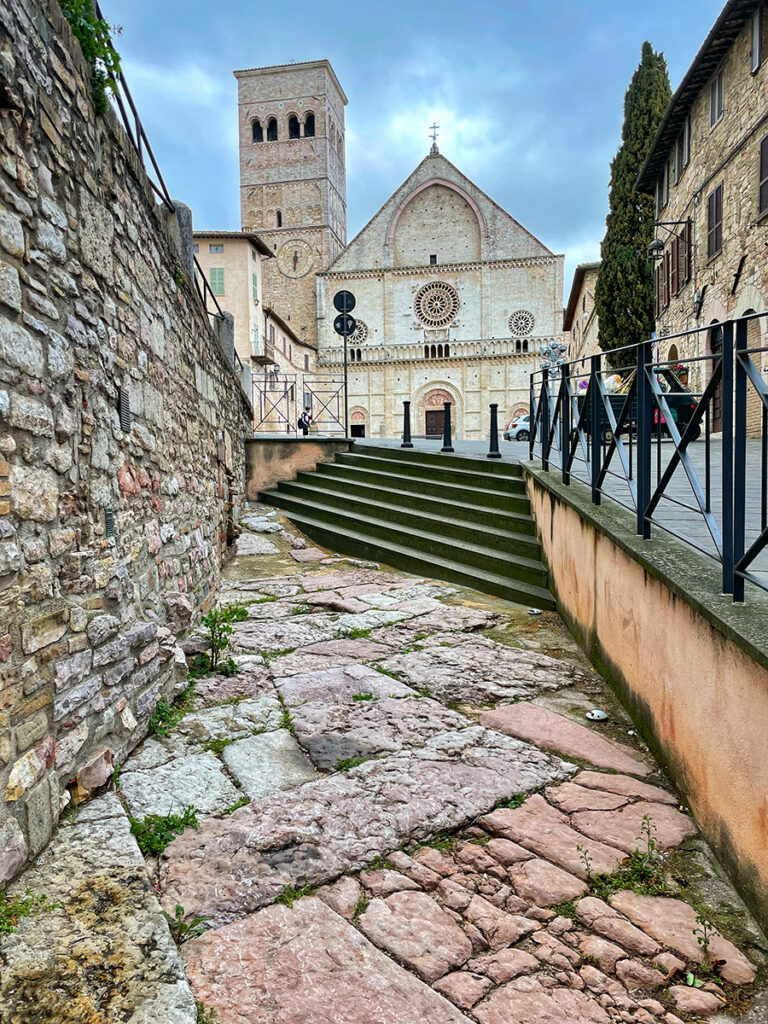
In front of San Rufino Cathedral, across the square, there is a perfectly-preserved section of Roman road. If you’ve seen the Roman road in Cordoba in Spain, you’ll recognize Roman engineering straight away.
This road – a wide surface of basalt composed of large limestone plates, with a step down on the side for a sidewalk, is thought to be the main pedestrian road leading to Bona Mater sanctuary.
It is thought to have connected two key areas of the Roman city – the sanctuary in the east to the Forum in the northern part of the city. The section of the road is not big but it feels smoother under your feet than Via Sacra leading from the Coliseum to Palatine Hill in Rome.
Domus Sesto-Properzio
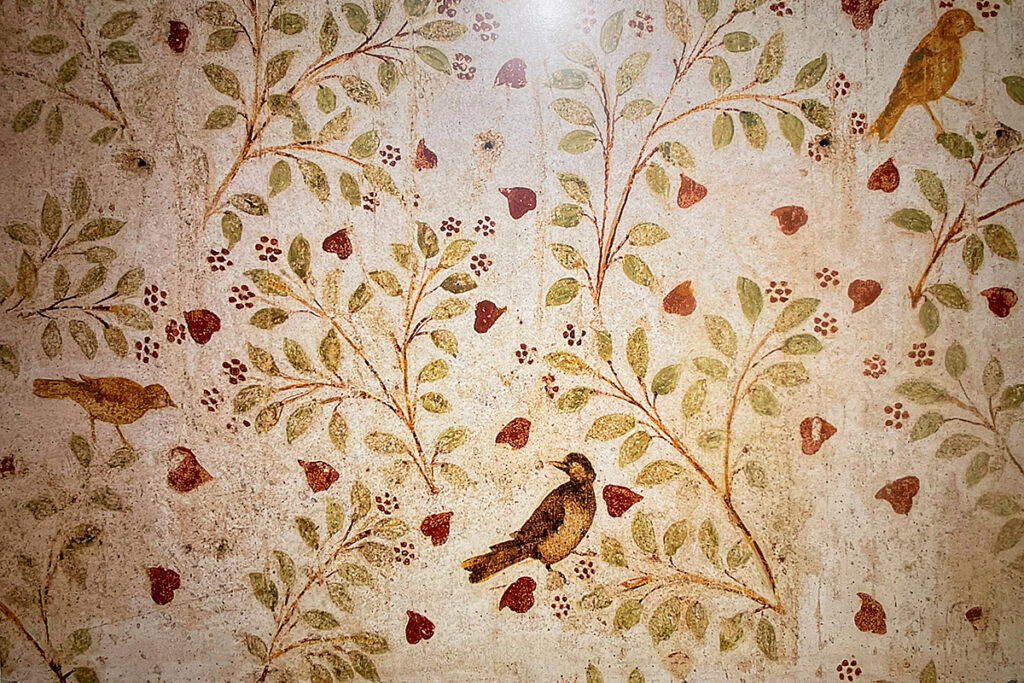
While today Assisi is mainly known as the birthplace of saint Francis, in Roman times, the town’s most notable native was poet Sextus Propertius who lived during the Augustan age.
He may have lived in a rich Roman domus (house) from the 1st century AD, that was discovered under the crypt of Santa Maria Maggiore in 1864 and excavated more extensively a century later. One of the inscriptions in the remnants of the house reads: “I kissed the house of the Muse”, leading the experts to believe that this may be the famous poet’s house.
The floors in the house are covered with mosaics while the walls still retain sections of refined decoration including paintings and poetry verses, one of which refers to Musae domus (House of the Muse). However, there is no archaeological or historical evidence to support this claim. In any case, the house clearly belonged to a wealthy person with a refined taste and love of poetry.
Given the fragile state of preservation of the site, it is only possible to access Domus Sesto-Properzio on an organized tour. You can book the tour at the Tourist office on Piazza del Comune.
Domus Lararium (Palazzo Giampè)
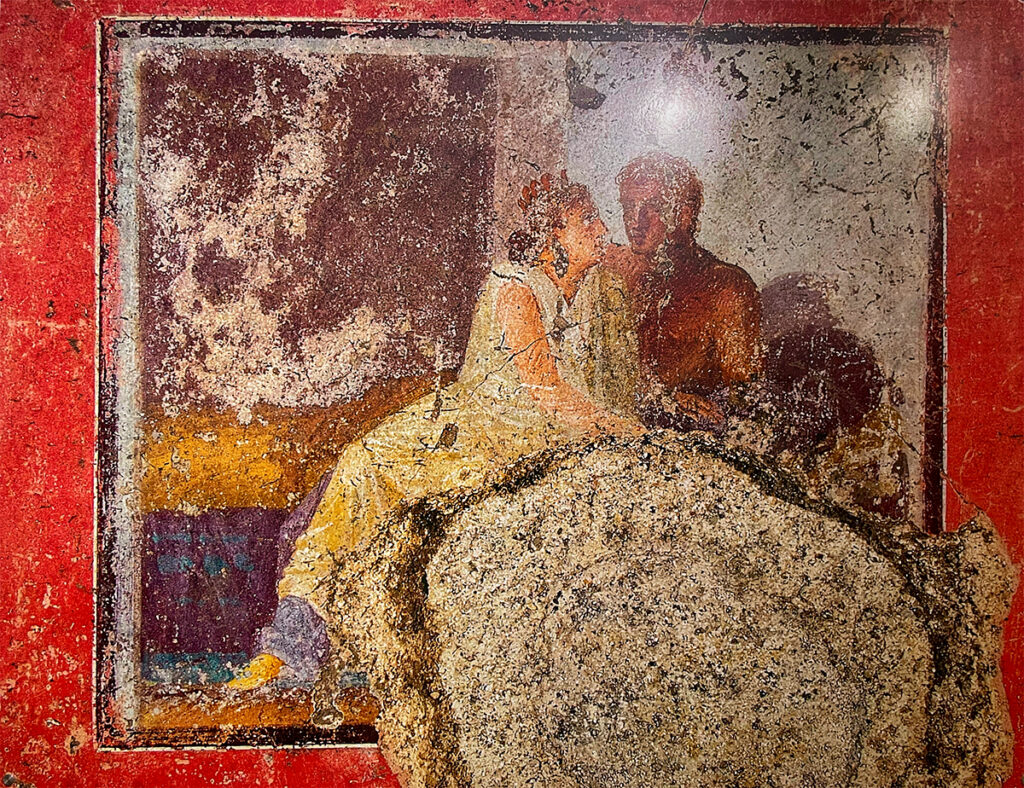
An even older house had been unearthed in the basement of Palazzo Giampè, following an earthquake in 2001. Named Domus Larario, the house dates back to the 1st century BC.
This house was spread over an area of 400 square meters, had 13 rooms with 4-meter-high ceilings and a colonnaded garden. Its walls were decorated with bright red and ocher panels defecting scenes of family life.
The house is named after one of the artifacts found here – a terracotta statue o possibly depicting the god Silvanus, and his statues are usually housed in a shrine called Lararium.
Three rooms that had been fully excavated, all had superb frescoes in the so-called 3rd Pompeian style ( 20 BC-62 AD) and are rarely found outside of Pompeii.
Some experts believe that “a flood caused by the rupture of the house’s two cisterns necessitated the space’s being sealed off between the first centuries B.C. and A.D”
And just as with Domus Sesto-Properzio, Domus Larario can only be accessed on an organized tour that you can book at the Tourist office.
Mausoleums, City Walls & Gates
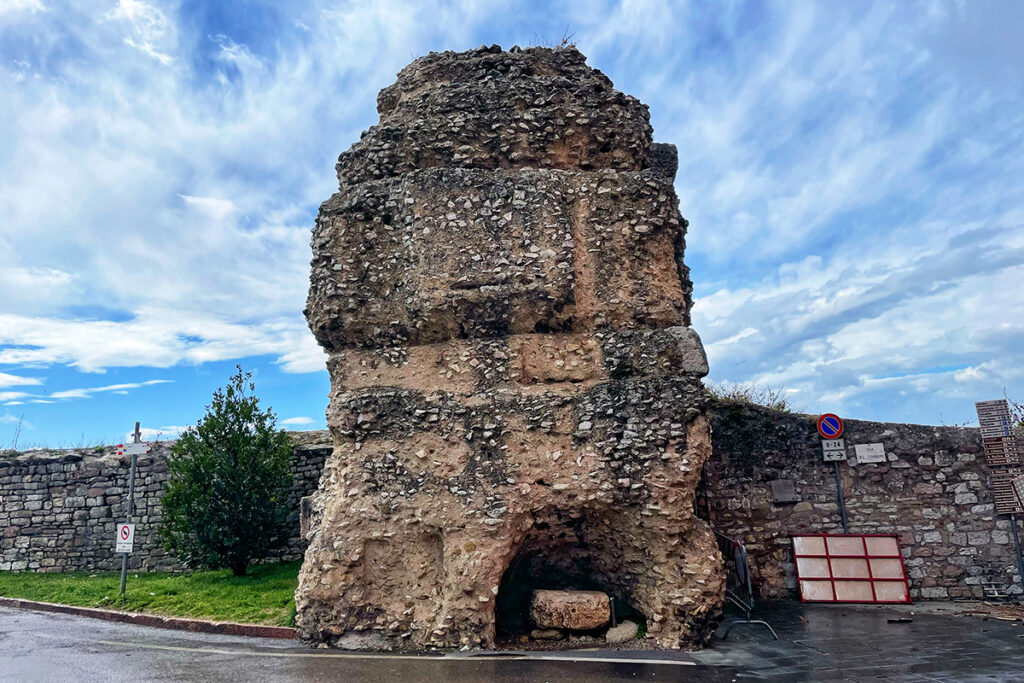
Since its founding in 150-100 BC, Asisium had been encircled by stone defence walls. Since the Roman times, two new walls were built, as the city continued to outgrow its walled confines. You can still see a section of the ancient Roman wall in the streets above Chiesa di San Pietro (St Peter’s church).
Since the Roman wall had the smallest perimeter of Assisi’s three city walls, the remnants of the gates you see in the innermost part of town are likely to be of Roman origin.
Beyond the perimeter of Roman city walls, there are remains of several Mausoleums. Romans buried their dead beyond the city walls for hygiene purposes. Today, these mausoleums look like eroded chunks of rock, but the fact that they are still standing indicates that they belonged to families that could spare the expense of building monumental shrines for their dead.
There are more Roman remnants concealed among the winding streets of Assisi than this guide introduces. The great thing about Assisi is that its historic monuments are all signposted and equipped with little plaques that identify them and give a brief introduction. Uncovering Roman Assisi is a delightful journey of wandering between the sites you know and finding those you don’t. An Indiana Jones-style treasure hunt.
More on Exploring Italy
- Renaissance Cats in Florence – A Feline Lovers Guide to Florentine Renaissance Art
- 3 Days in Florence – Exploring the Cradle of the Renaissance
- 2 Days in Florence: Detailed and Flexible Itinerary & Tips
- 1 Day in Florence Itinerary – the Best of the Italian Renaissance
- Things to Do in Florence in Winter and Why Visit in Winter
- Leonardo da Vinci in Florence: In the Footsteps of the Renaissance Master
- Guide to Visiting Palazzo Vecchio: Must-see Art and Hidden Gems
- Medici Florence – a Self-Guided Walk in the Cradle of the Renaissance
- 18 Weekend Breaks in Italy: Top Destinations to Visit and Things to Do
- Quo Vadis – Assisi B&B Where Comfort Meets Medieval Charm

